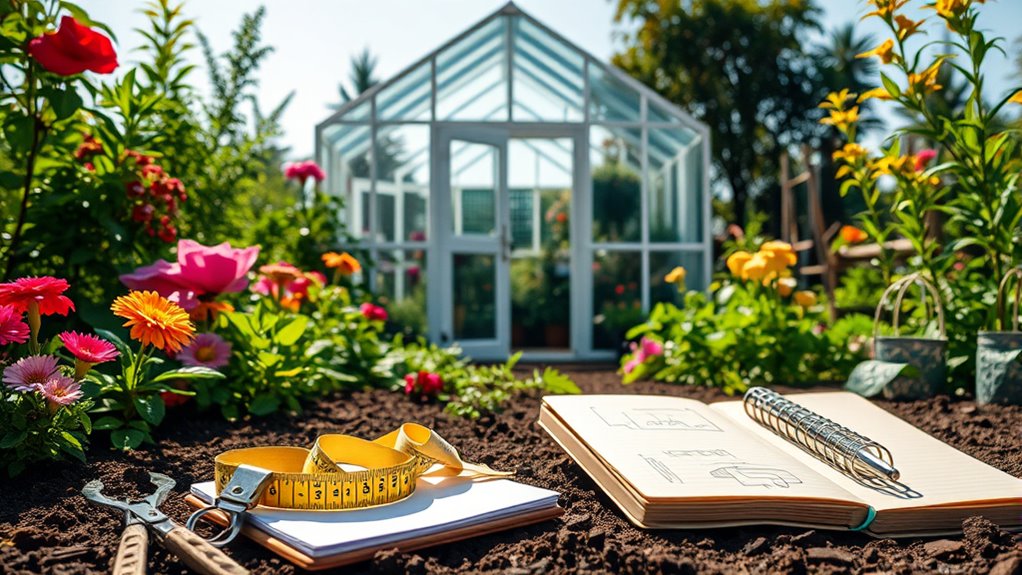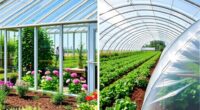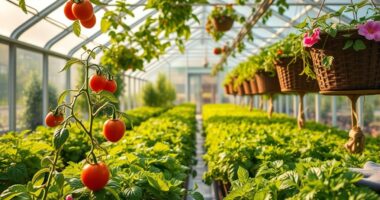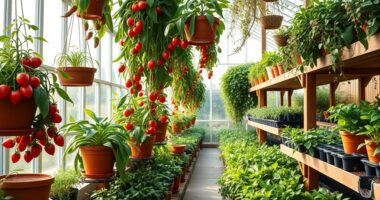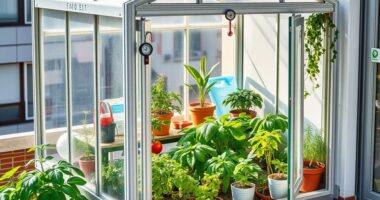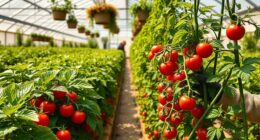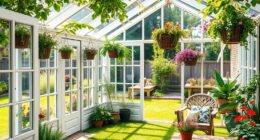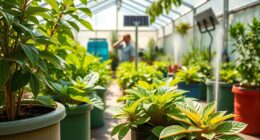To choose the right size greenhouse for your garden, start by measuring your available space and assessing your gardening goals. Think about the type and number of plants you want to grow. Consider your budget, as larger greenhouses can be more expensive. Don’t forget to factor in height for ventilation and future expansion opportunities. Understanding local regulations is also key. If you want to explore more details to help you decide, there’s plenty more to discover!
Key Takeaways
- Measure your garden area and ensure it gets at least six hours of sunlight daily for optimal plant growth.
- Define your gardening goals, including the types of plants and the number you plan to grow, to determine suitable greenhouse size.
- Consider the standard sizes of greenhouses, from small (6×4 ft) for limited space to larger (over 12 ft wide) for commercial use.
- Evaluate your budget, factoring in initial setup costs, material choices, and future maintenance expenses when selecting a greenhouse size.
- Research local zoning laws and building codes to ensure your chosen greenhouse size complies with regulations and permits.
Assessing Your Available Space

When you assess your available space for a greenhouse, it’s essential to start with accurate measurements of the area where you plan to set it up.
Ensure the site receives at least six hours of direct sunlight daily, as this is crucial for optimal plant growth.
Check that the ground is well-drained and nearly level to prevent water pooling and structural issues.
Leave extra space around the greenhouse for easy maintenance and access.
Also, consider any surrounding features, like pathways or raised beds, that may impact the greenhouse’s size and placement.
If you’re limited on space, small greenhouses work well, while larger ones suit extensive gardening projects, so choose wisely based on your available area. Additionally, incorporating native species in your greenhouse can enhance local biodiversity and support wildlife.
Defining Your Gardening Goals
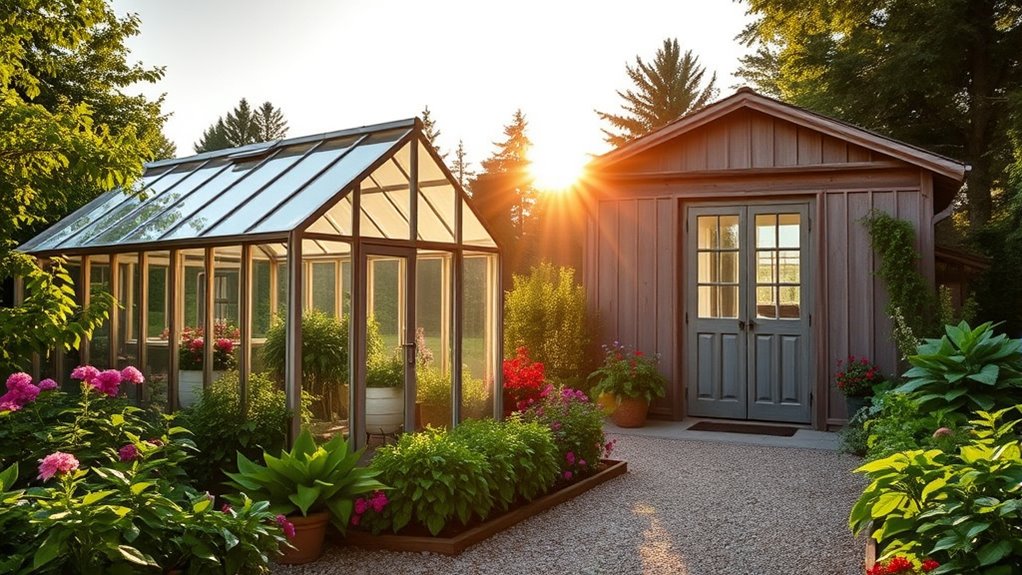
Defining your gardening goals is crucial for selecting the right greenhouse size and features that match your needs.
Start by considering the types of plants you want to grow. If you’re focused on herbs and leafy greens, a small greenhouse might suffice. For vegetables like tomatoes and cucumbers, you’ll need more space, while fruit trees require larger structures.
Consider the plants you wish to grow; small herbs need little space, while larger vegetables and fruit trees require more room.
Think about how many plants you plan to cultivate—small collections fit in compact greenhouses, but larger gardens need more room. Your growth objectives matter too; year-round production demands advanced features like insulation and heating.
Lastly, evaluate care requirements, such as air circulation and lighting, to ensure your greenhouse supports your gardening ambitions effectively.
Budget Considerations for Your Greenhouse

Choosing the right size greenhouse involves careful budget considerations, as your financial limits can significantly influence the options available to you. The initial costs vary greatly with size; larger greenhouses mean higher expenses due to materials and labor.
You’ll also need to think about material selection—glass, polycarbonate, and plastic come with different price tags and benefits. Remember that larger structures will increase your energy consumption for heating and cooling. Strategic planning for energy efficiency can help mitigate these costs. Additionally, understanding filial responsibility laws may provide insights into potential financial planning for elder care that could influence your overall budget. Furthermore, it’s essential to consider assisted living expenses when evaluating your financial commitments. Effective planning for RMDs can also help you manage future financial needs as they relate to your greenhouse investment. Maintenance is another factor; smaller greenhouses are generally easier to care for. Finally, consider future scalability to avoid expensive rebuilds later. DIY enthusiasts can benefit from assessing their specific gardening goals to determine the most cost-effective size.
Implementing efficient systems for energy and water can help manage ongoing costs, ensuring your greenhouse remains both functional and budget-friendly.
Understanding Standard Greenhouse Sizes
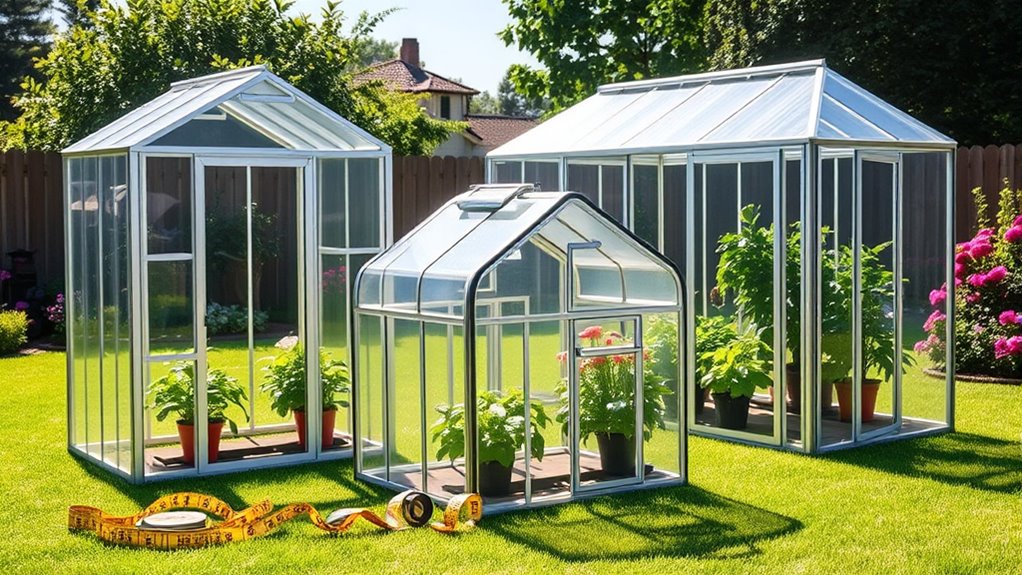
Understanding standard greenhouse sizes is crucial for maximizing your gardening potential, especially since the right dimensions can significantly impact your growing experience.
Small greenhouses, ranging from 6×4 ft to 6×8 ft, are perfect for urban gardeners, allowing you to start seeds or grow herbs and a few vegetables in limited space. If you need flexibility, consider portable pop-up models around 6-8 ft wide.
Medium greenhouses, from 8-10 ft in width, offer more room for diverse plants and activities like potting and harvesting. They also accommodate shelving for increased capacity.
For larger scale needs, greenhouses over 12 ft wide support commercial use and specialized zones.
Choose the size that best fits your gardening goals and available space.
Importance of Height and Ventilation

When you consider setting up a greenhouse, height and ventilation play crucial roles in creating an optimal growing environment.
A taller greenhouse allows more light penetration, which is essential for plants needing high light conditions. It also helps regulate temperature fluctuations, promoting healthier growth and increasing crop yields by providing vertical space for multiple layers of crops.
Proper ventilation is equally important; it helps manage temperature and moisture levels, preventing heat stress and fungal diseases. Good airflow also supports air circulation and can help control insect populations.
Incorporating Additional Features

To create a truly functional greenhouse, you should consider incorporating additional features that enhance both practicality and comfort.
Adding shelves at various heights maximizes your space and accommodates different plant sizes, while storage cabinets keep your tools organized.
For relaxation, integrate weather-resistant seating areas with comfortable furniture that allows easy movement among your plants.
Don’t forget to implement efficient irrigation systems—drip irrigation saves time and ensures consistent moisture.
Implementing efficient drip irrigation systems not only saves time but also guarantees your plants receive consistent moisture.
If you’re propagating plants, consider benches with soil warming cables and reliable electricity supply.
Finally, improve climate control with heating systems, shading options, and automated ventilation to maintain optimal conditions.
These features not only boost your gardening experience but also help your plants thrive.
Planning for Future Expansion
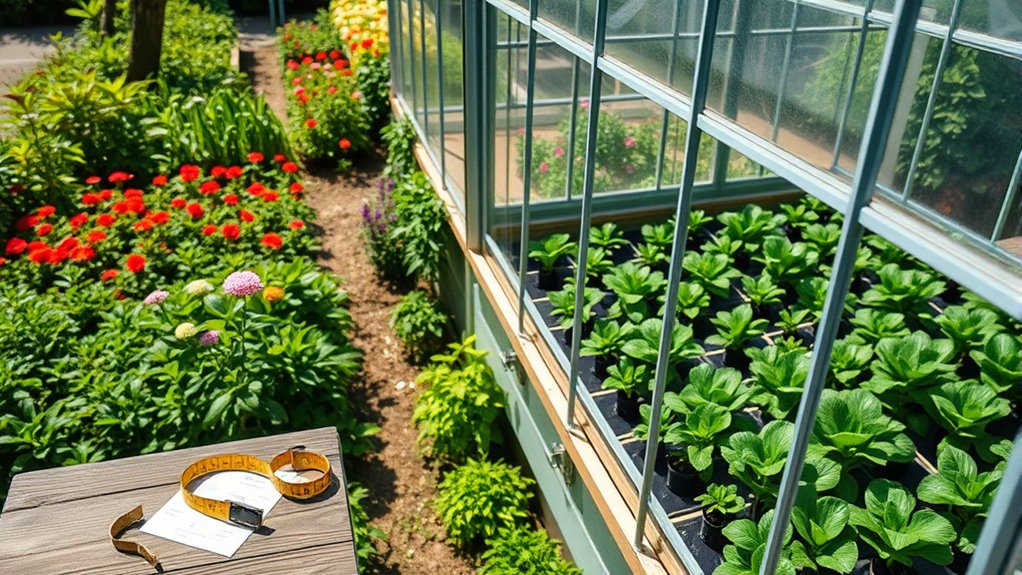
As your gardening ambitions grow, planning for future expansion is essential to ensure your greenhouse can adapt to your evolving needs.
First, assess your available land and maintain a minimum of 3 feet of clearance around the greenhouse for easy access. Think about pathways that facilitate movement and ensure proper drainage to avoid water issues.
When budgeting, consider initial costs and long-term savings from high-quality materials. Opt for modular systems and scalable equipment that can integrate future technology.
Don’t forget to plan for diverse plant growth by utilizing vertical gardening and compact varieties.
Lastly, ensure your design is flexible, allowing for easy expansion without disrupting your current operations. This proactive approach will keep your greenhouse thriving for years to come.
Navigating Local Regulations and Permits

Navigating local regulations and permits can feel daunting, but understanding these requirements is crucial for a successful greenhouse project.
Start by checking your municipality’s zoning regulations, as they dictate where you can build your greenhouse. Often classified under agricultural use, greenhouses might be allowed in residential zones, but you need to verify specific allowances.
Building permits may be necessary depending on your greenhouse’s size, and additional permits for utilities could apply. Small structures may not require permits, but this varies by location.
Be prepared to educate local officials on your plans and address any concerns from neighbors. Regularly review local ordinances to ensure ongoing compliance and avoid potential fines or legal issues.
Frequently Asked Questions
What Materials Are Best for Greenhouse Construction?
When considering materials for greenhouse construction, think about your budget and climate.
For frames, wood offers charm and durability, while metal provides strength. Cover with glass for aesthetics or polycarbonate for insulation.
A concrete foundation is solid, but treated wood or gravel can work too.
Don’t forget insulation materials like weather stripping and caulk, which keep your greenhouse energy-efficient.
Choose wisely to create a thriving environment for your plants!
How Do I Maintain Optimal Humidity Levels?
Imagine your plants as delicate dancers, twirling gracefully in a perfectly balanced atmosphere.
To maintain optimal humidity levels, you’ll want to monitor conditions regularly with hygrometers and thermometers. Adjust ventilation to allow fresh air, and use humidifiers or dehumidifiers as needed.
Keep an eye on water management to avoid excess moisture, and ensure proper plant spacing for air circulation.
With these steps, your garden’s dancers will flourish in harmony.
Can I Use a Greenhouse for Aquaponics?
Yes, you can absolutely use a greenhouse for aquaponics! It creates an ideal environment for both fish and plants, allowing you to grow year-round, regardless of the weather.
You’ll benefit from better temperature control, reduced pests, and increased water efficiency. Plus, with a well-designed greenhouse, you can maximize your yields.
Just ensure you have the right setup, including proper insulation and strategic placement of your fish tanks for optimal results.
What Pests Are Common in Greenhouses?
In greenhouses, you’ll often encounter pests like aphids, spider mites, and whiteflies. These little invaders feed on your plants, causing damage and stunted growth.
Thrips and fungus gnats can also wreak havoc, spreading diseases and harming roots. To keep your plants healthy, regularly inspect for signs of these pests and consider using natural predators or organic sprays to manage infestations.
Staying proactive will help protect your greenhouse garden from these common threats.
How Often Should I Water Plants in a Greenhouse?
Watering isn’t just a routine; it’s an art.
You’ll find that the frequency varies with seasons and plant types. In warmer months, your plants will thirst more, while in cooler times, you can cut back.
Leafy greens crave consistent moisture, while fruiting plants need extra water during their peak.
To ensure healthy growth, check the soil moisture and adjust your routine based on climate conditions and your plants’ specific needs.
Conclusion
Choosing the right greenhouse size isn’t just about fitting it into your backyard; it’s about creating a thriving garden space that meets your needs. Think of it as crafting a cozy nook in the wild west—where every plant has room to flourish. By considering your space, goals, and budget, you can create a greenhouse that’ll serve you well for years to come. So, go ahead and cultivate your green thumb; your future garden will thank you!
